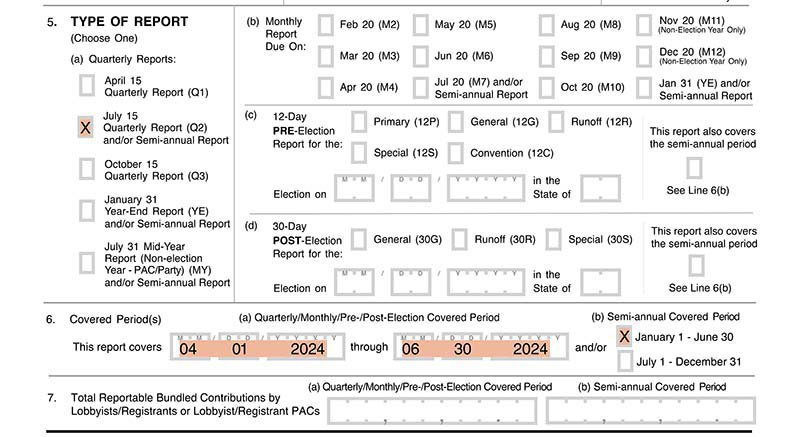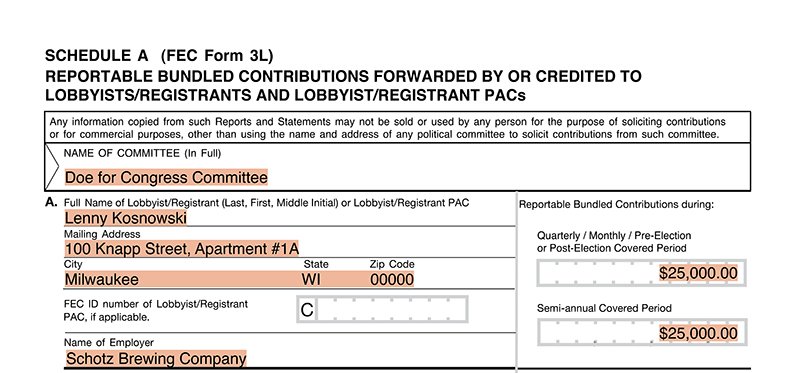Lobbyist bundling disclosure
The Federal Election Campaign Act and Commission regulations require special reporting of certain contributions that are collected or "bundled" by lobbyists/registrants, or by political action committees (PACs) that are established or controlled by lobbyists/registrants, on behalf of authorized committees of federal candidates, political party committees, and leadership PACs. Committees receiving these contributions must file Form 3L and disclose certain information about any lobbyist/registrant or lobbyist/registrant PAC that forwards, or is credited with raising, two or more bundled contributions aggregating in excess of a specific reporting threshold within a certain "covered period" of time. These requirements apply to both in-kind and monetary contributions. The reporting threshold for calendar year 2024 is $22,700.
Who must file
All campaign committees, leadership PACs, and political party committees must file Form 3L when they receive two or more bundled contributions that aggregate in excess of $22,700 from a lobbyist/registrant or lobbyist/registrant PAC during a particular "covered period." The threshold amount is indexed annually and updated amounts are typically announced early in each calendar year.
Definitions of lobbyist/registrant and lobbyist/registrant PAC
The rules define a lobbyist/registrant as a current registrant under section 4(a) of the Lobbying Disclosure Act of 1995 (LDA) or an individual listed on a current registration or report filed under sections 4(b)(6) or 5(b)(2)(C) of the LDA.
A lobbyist/registrant PAC is any political committee that a lobbyist/registrant "established or controls." A lobbyist/registrant "established or controls' a political committee if he or she is required to make a disclosure to that effect to the Clerk of the House of Representatives or the Secretary of the Senate under Section 203 of the Honest Leadership and Open Government Act of 2007.
A PAC is considered to be a lobbyist/registrant PAC if it is a separate segregated fund (SSF) whose connected organization is a current registrant, or if a lobbyist/registrant had a primary role in the establishment of the committee or directs the governance or the operations of the committee.
Disclosure is triggered based on the activity of persons “reasonably known” by the reporting committee to be lobbyists/registrants or lobbyist/registrant PACs. In order for reporting committees to determine whether a person is reasonably known to be a lobbyist/registrant or a lobbyist/registrant PAC, the committee is required to consult the websites of the Clerk of the House, the Secretary of the Senate, and the FEC.
The House and Senate websites identify registered lobbyists and registrants, while the FEC website identifies whether a political committee is a lobbyist/registrant PAC. A computer printout of a screen capture showing the absence of the person’s name on the House, Senate, or FEC websites on the date in question may be used as conclusive evidence demonstrating that the reporting committee consulted the required websites and did not find the name of the person in question. However, a reporting committee is subject to the disclosure requirements if it has actual knowledge that the person's name is required to be listed on one or more of these websites.
Each PAC that qualifies as a lobbyist/registrant PAC must indicate this designation on its Form 1 (Statement of Organization). Newly-formed committees filing Form 1 for the first time must disclose this designation on their initial filing. Existing committees that qualify as lobbyist/registrant PACs must amend their Form 1 within 10 days of any change to the information disclosed.
Bundled contributions
A bundled contribution is any contribution that is either (1) forwarded to a reporting committee by a lobbyist/registrant or lobbyist/registrant PAC; or (2) received by the reporting committee and credited to a lobbyist/registrant or lobbyist/registrant PAC through "records, designations, or other means of recognizing that a certain amount of money has been raised."
A forwarded contribution is one that is delivered, either physically or electronically, to the reporting committee by the lobbyist/registrant or lobbyist registrant PAC, or by any person that the reporting committee knows to be forwarding a contribution on behalf of a lobbyist/registrant or lobbyist/registrant PAC. These contributions count toward the bundling disclosure threshold regardless of whether the committee awards any credit to the lobbyist/registrant or lobbyist/registrant PAC.
"Credited" contributions on the other hand, do not necessarily have to be physically handled by a lobbyist/registrant or lobbyist/registrant PAC. Credit can be given by records, designations, or other means of recognizing that a certain amount of money has been raised by that lobbyist/registrant or lobbyist/registrant PAC.
Crediting through "records" means that the reporting committee or candidate attributes contributions to a lobbyist/registrant or lobbyist/registrant PAC through written evidence. Crediting through “designations or other means of recognizing that a certain amount of money has been raised” means that the reporting committee has given benefits to a lobbyist/registrant or lobbyist/registrant PAC for having raised a certain amount of contributions. Examples include, but are not limited to such designations as:
- Titles given to persons based on their fundraising;
- Tracking identifiers assigned by the reporting committee and included on contributions or contribution-related material that may be used to maintain information about a person’s fundraising;
- Access given to lobbyist/registrants or lobbyist/registrant PAC (such as through invitations to special events) as a result of their fundraising levels; and
- Mementos (such as photographs with the candidate or autographed copies of books authored by the candidate) given to persons who have raised a certain amount of contributions.
This list is not exhaustive, and "designations or other means of recognizing that a certain amount of money has been raised" need not be in writing.
Covered periods
There are two overlapping covered periods for filing Form 3L:
- A six-month semi-annual covered period; and
- A period that coincides with a committee’s regular FEC reporting periods, depending on whether the committee is a quarterly or monthly filer (except that Form 3L filed in July and January will cover the preceding six months).
As noted above, a committee must file Form 3L for a covered period if, within that covered period, it receives two or more bundled contributions forwarded by, or credited to, a lobbyist/registrant or lobbyist/registrant PAC, and the contributions during that period aggregate in excess of the threshold.
Semi-annual covered period
All reporting committees with bundled contributions to disclose must file a report covering the semi-annual periods of January 1 through June 30 and July 1 through December 31. Totals for the first six months of the year will appear on quarterly filers' July 15 report and on monthly filers’ July 20 report. All reporting committees must disclose totals for the second half of the year on their January 31 Year-End report. (In a non-election year, committees that file only semi-annually should file Form 3L on July 31 and January 31 of the next year.) A semi-annual report is required only if the committee exceeded the reporting threshold for bundled contributions during that specific semi-annual period. However, if the threshold has not been exceeded during that particular semi-annual period, a semi-annual report is not required.
Quarterly/monthly covered period
The covered period for reporting committees that file reports on a quarterly schedule in an election year includes the semi-annual periods above and also the calendar quarters beginning on January 1, April 1, July 1, and October 1, as well as the pre-and post-election reporting periods (including runoff or special elections), if applicable. Authorized committees of House and Senate candidates have the same quarterly covered period for a non-election year as in an election year. However, leadership PACs or party committees that file quarterly in an election year file campaign finance reports semi-annually in a non-election year. Therefore, in a non-election year, these reporting committees must file Form 3L only for the semi-annual covered periods and any pre- and post-special election reporting periods, if applicable.
Example of indicating covered period on Form 3L:

For reporting committees that file normal disclosure reports on a monthly basis, the covered periods include the semi-annual periods above and each month in the calendar year, except that in election years they file for the pre- and post-general election reporting periods in lieu of the November and December reports. Alternatively, monthly filers may choose to file lobbyist bundling reports on a quarterly basis, provided that they notify the Commission in writing of its intention to do so. The reporting committee may change its filing frequency no more than once per calendar year.
Filing Form 3L
Reporting committees that must file Form 3L after crossing the lobbyist/bundling threshold in any covered period must disclose the following:
- The name of each lobbyist/registrant or lobbyist/registrant PAC;
- The address of each lobbyist/registrant or lobbyist/registrant PAC;
- The employer of each lobbyist (if an individual); and
- The aggregate amount of bundled contributions forwarded by or received and credited to each.
Example of disclosing a bundled contribution on Form 3L, Schedule A:

Note that the lobbyist bundling regulations do not change a committee’s reporting obligations under the rules for earmarked contributions. Committees that receive earmarked contributions through a conduit are still required to report such conduit activity on their regularly scheduled FEC report.
Paper vs. electronic filing
Committees that electronically file FEC reports must file Form 3L electronically. Paper filers file Form 3L on paper with the FEC.